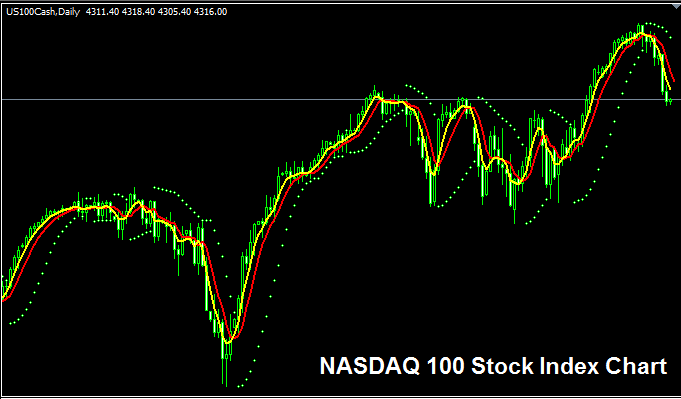NASDAQ 100 Index
NASDAQ 100 is an index that include 100 of the biggest firms shown in the NASDAQ Index exchange market which aren't in the financial sector. The calculation of this index is based in a weighted component of market capitalization of listed 100 securities. The 100 companies shown on this stock index are re-evaluated quarterly.
The 100 companies used to calculate this index aren't necessarily based in US: international foreign firms are also included so long as they are listed in the NASDAQ Stocks Exchange Market.

NASDAQ 100 Index Trade Chart
NASDAQ100 Index chart is shown and displayed above. On above example this Index is named USA 100CASH. As a trader you want to search & find a broker that offers NASDAQ100 Index trading chart so that you as a trader can begin to trade it. The example Which is shown above is that one of NASDAQ100 Stock Index on the MetaTrader 4 FX and Platform.
Other Info about NASDAQ 100 Index
Official Index Symbol - QQQ:IND
The 100 component stocks that make up NASDAQ100 Index are calculated using a weighted component for each stock. The constituent stocks & weighting for each Stock Index is re-evaluated quarterly.
Strategy to NASDAQ100 Stock Index
NASDAQ100 Index formula of calculating makes it more volatile and hence there are wider swings(more volatile swings) in the price movement of this index. The index has a weighting component/constituent for each Index included on this index. Although this index in general moves upward over long term because the USA economy also indicates robust growth.
As a indexes trader you want to be biased and keep on buying as the index heads and moves upward. When the US economy is doing well, stocks that make up NASDAQ100 index will keep gaining in values & thus this index is likely to keep heading in an upward market trend. A good stock index trading strategy to trade this Stock Index would be to buy dips.
During Economic SlowDown and Recession
During economic slow-down & recession times, firms begin to report slower profits & slower growth projections. It's due to and because of this reason that traders start to sell shares of corporations that are reporting & recording lower profits and hence the Indices tracking these given stocks also will start to go downward.
Hence, during these times, market trends are much more likely to be heading downwards & you as a trader should also adjust your trading strategy accordingly to suit the ruling downwards trends of the index which you as a trader are trading.
Contracts and Details
Margin Required for 1 Lot - $ 30
Value per Pips - $0.1
NB: Even though general and overall trend is generally moves upward, as a trader you've to consider and factor in the daily market volatility, on some of the days the Index might move in a range or even retrace & retracement, market retracement/correction move might also be a large one at times & therefore as the trader you need to time your entry precisely using this trading strategy: Stock strategy & at same time use the proper and appropriate money management methods & guidelines just in case there is unexpected market trend volatility. About money management guidelines and strategies in indices topics: What is index equity management and money management system.
Get More Topics and Courses:
- How Do You Set FX Sell Stop Order in MetaTrader 4 Platform?
- Strategy for SWI 20 in FX
- FRA 40 MT4 FRA 40 Name in MT4 Software
- Strategies for EURO STOXX 50 Index
- Entry Stop Forex Orders: Buy Stop Forex Order and Sell Stop Order
- SMA, EMA, LWMA & SMMA Moving Averages Index Examples
- EURRUB System EURRUB Trade Strategy
- Setting up XAU USD Practice Account & MT4 Gold Platform


